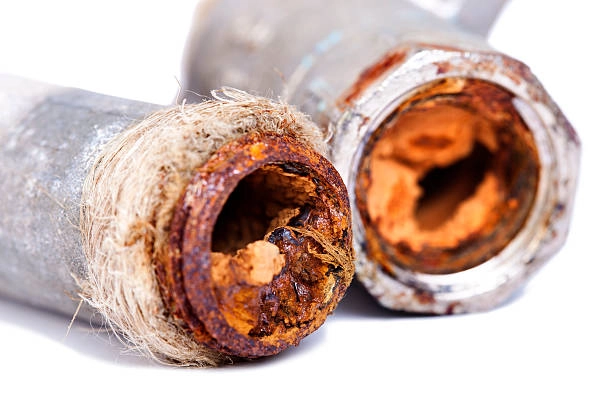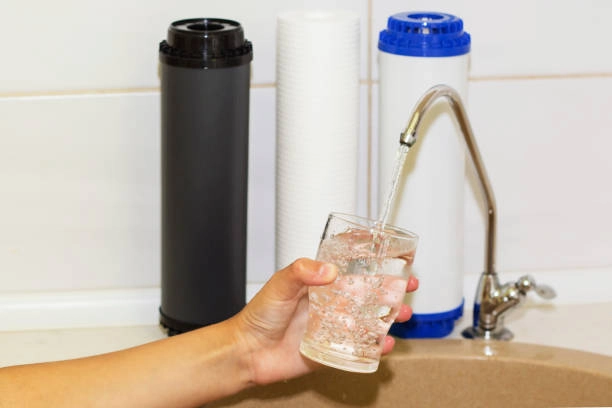Well water is one of the most popular water sources, especially in rural areas. Apart from being a cost-effective way to access water, it provides a nearly endless supply. And since it is a groundwater source, it is often cleaner than surface water.
But that doesn't mean it's pure!
All groundwater, including well water, can be contaminated through seepage, naturally occurring chemicals, waste, and pesticides. And among the many water pollutants, iron is one that can easily make its way into your well. Take, for instance, during the rainy or winter season.
When rain or melted snow seeps into soil that has high iron contents, the iron will dissolve into the water and the mixture can trickle into your well, contaminating it. Additionally, if the pipes or well casing is made from iron and any of them oxidizes, they will corrode and dislodge the iron into the water, ruining the water’s quality.
This article focuses on the adverse effects of iron in water and ways to detect it, with a special focus on how to remove iron from well water and maintain clean, safe water at home.
How to detect the presence of iron in water
Indicators that scream the presence of ferric or ferrous iron in water include:
- Reddish brown sediment after water is allowed to stand
- Yellowish, brownish, or reddish water flowing from your faucets
- Reddish brown or yellowish sludge in the piping system
- Metallic-tasting water
If you notice any or all of these three indicators, it's best to take a water analysis that tests for the presence of iron. The analysis will also show the iron's concentration and showcase the presence of other contaminants - if any.
The harm of iron to your body?
Iron is an essential mineral that helps in various biological processes such as transporting oxygen and building immunity. People will often get the recommended iron levels from food and rarely from drinking water. As such, hydrating with a cup that has traces of iron does not present a health risk.
However, considering that iron may encourage the growth of harmful microorganisms is a cause for concern. Worse still, drinking iron-polluted water for prolonged durations may lead to high iron quantities in the body, causing diabetes, nausea, liver damage, stomach issues, and heart complications.
Further reports show that bathing in iron-rich water might dry out the skin and hair, and exacerbate eczema as well as other skin conditions.
For these reasons, finding an effective remove iron from well water system is an excellent first step to safeguarding your family.
How does iron in water damage your home
Iron is known to stain anything it comes into contact with. Since the polluted water will be a reddish-brown, yellowish, or brownish color, it will cause your faucets, showerheads, dishwashers, boilers, and washing machines to discolor.
Also, the iron is likely to oxidize when it comes into contact with water and air, forming rust. If left unattended, the rust formed will accumulate and clog your pipes and faucets, requiring immediate plumbing services.
Installing a filter for water beforehand is the best course of action to avoid such damages. Not only will it save you the trouble of costly repairs, but will also ensure your home is in top-notch condition for years — especially if you already know how to remove iron from well water effectively.
Common types of iron in well water
Before you find out how to remove iron from water well effectively, you must understand the different types of iron - which are:
Ferric iron
You can easily tell the presence of ferric iron because the water will appear red or yellow at first sight. Since this type of iron is in its oxidized state, it is insoluble - the reason why it is visible.
Bacterial iron
Bacterial iron occurs when bacteria found in the well mix with the iron, creating a thick viscous substance. Such situations result from poor well construction, and not properly flushing the water system after repairing or installing a water pump/heater.
Bacterial iron is notorious for clogging pipes as well as faucets. It also damages sediment filters and softeners, making it the worst form of iron you can find in your well.
Ferrous iron
You cannot identify the presence of ferrous iron right away because it dissolves in water and the contaminated contents flowing from the faucet will still be crystal clear.
However, if you leave the glass of water to stand for some time, the ferrous iron will oxidize and you will notice reddish-brown particles in the bottom of the cup.
Methods for removing iron from well water
Well water often contains elevated levels of iron that can affect its taste, color, and safety. Over time, this contamination can stain fixtures, damage appliances, and even encourage bacterial growth inside plumbing systems. One of the most reliable ways to deal with this issue is by installing KDF water filters, which effectively remove iron and other impurities while improving overall water quality.
Benefits of KDF water filters for well water
KDF water filters provide one of the most efficient and long-lasting solutions for improving well water quality, especially when it comes to removing iron and other heavy metals. The filtration media — composed of high-purity copper-zinc granules — works through a process called redox (oxidation-reduction), which changes harmful contaminants into harmless compounds. For iron, this means converting soluble ferrous iron into insoluble ferric hydroxide, which can then be easily flushed out during system backwashing.
Key benefits of KDF water filters for well water:
- Effective iron removal: Converts dissolved ferrous iron into insoluble ferric hydroxide that’s easily washed away.
- Bacteria and algae control: The redox process naturally inhibits bacterial growth inside the filtration system.
- Chlorine and odor reduction: Helps neutralize chlorine, hydrogen sulfide, and unpleasant metallic or sulfur smells.
- Prevention of scale buildup: Reduces hardness-related deposits that damage pipes and appliances.
- Long service life: Durable filtration media that lasts for years with minimal maintenance.
- Eco-friendly performance: No need for chemical additives or frequent filter replacements.
When combined with sediment or carbon filters, KDF technology forms a robust multi-stage purification system that not only removes iron but also enhances the taste, smell, and overall quality of your well water — ensuring cleaner, safer, and fresher water for your home.
KDF water filters are ideal as POE treatment solutions and can be used alone or in conjunction with other purifiers for optimal results.
Find the Perfect Solution for Your Well Water with Filterway
Having iron in your water may not have adverse health consequences but it can discolor your fixtures and home appliances, damaging them. If bacterial iron is flowing through your faucets, the chances of catching water-borne illnesses increases.
For this reason, finding the best system to remove iron from well water is of paramount importance. But considering every homeowner has their unique purification needs, you must pick a system that works for you.
At Filterway, helping you find the ideal filter for well water that prevents iron from flowing into your home is our core business. Our years of experience in the water treatment industry have allowed us to accumulate immense knowledge of the different iron pollutants and contamination levels. Thus, we leverage our expertise to advise you on the best system for you.
We have a host of whole-house and point-of-entry systems for sale, as well as replacement cartridges for various filters.
Contact us today for more information.
How to remove iron from well water FAQ
How can I tell if my well water contains iron?
Common signs include reddish-brown or yellowish stains on sinks and fixtures, metallic-tasting water, and sediment buildup in pipes. You can confirm the iron concentration by performing a professional water test.
How often should I replace or maintain my iron filter?
Maintenance frequency depends on your water quality and the type of filter system. KDF filters generally require minimal maintenance and can last several years, especially if backwashing is performed regularly.
Can I use KDF filters with other filtration systems?
Yes. KDF filters work perfectly in combination with carbon or sediment filters as part of a multi-stage purification setup. This enhances overall efficiency — improving taste, odor, and clarity of your well water.
What is the best way to remove iron from well water?
The most effective methods include KDF water filters, oxidation-filtration systems, and water softeners. KDF filters stand out for their durability and eco-friendly performance — they convert dissolved iron into a harmless, easily removable form.















